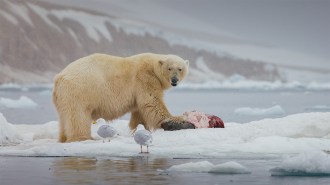4 ways to put the 100-degree Arctic heat record in context
A remote Siberian town recently reported a temperature of 100.4° Fahrenheit

Global warming is particularly rapid in the Arctic, such as in the Yamal region of northwestern Siberia (shown). In June, one Siberian town hit a record high temperature, following six months of unprecedented heat in the region.
Georgy_Golovin/iStock/Getty Images Plus
- More than 2 years ago
On June 20, a remote Siberian town called Verkhoyansk logged a temperature of 38° Celsius (100.4° Fahrenheit), likely setting a new high-temperature record for the Arctic Circle (SN: 6/23/20).
But that new record didn’t occur in a vacuum: It’s part of a long-term trend of historically hot temperatures in Siberia linked to climate change, and a larger, even more worrisome trend of amplified warming over the last few decades throughout the Arctic region. Here are four things to know about this new Arctic record.
Siberia has been sweltering under months of unprecedented warmth.
Globally, May 2020 was the hottest May on record, according to the European Union’s Copernicus Climate Change Service. Much of that record-breaking heat is the result of warming in Siberia, where May temperatures were as much as 10 degrees C higher than average, says climate scientist Martin Stendel of the Danish Meteorological Institute in Copenhagen.
This extreme event in Siberia would not have happened without human-caused climate change, Stendel says. “If we assume for a moment that we don’t have any climate change,” there is a 1 in 100,000 chance of such a hot May in the region, he says. “It’s virtually impossible.”
In fact, Stendel says, Siberian temperatures during the entire six-month period from December 2019 through May 2020 were also “quite extraordinary.” These temperatures were the warmest on record going back to 1979, and likely unprecedented within the last 140 years, according to the Copernicus Climate Change Service.

Trustworthy journalism comes at a price.
Scientists and journalists share a core belief in questioning, observing and verifying to reach the truth. Science News reports on crucial research and discovery across science disciplines. We need your financial support to make it happen – every contribution makes a difference.
This particular high temperature probably isn’t unique within the rapidly warming Arctic.
“We don’t have a whole lot of stations [in the region],” says Randall Cerveny, a meteorologist at Arizona State University in Tempe. “There are large portions that we are not monitoring. It is possible that there are higher temperatures in places [where] we don’t have instruments.”
Still, officially noting this record is a way to mark a more symbolic milestone for the whole region. The World Meteorological Organization, which archives global records of weather extremes, hasn’t previously maintained a category of extremes specifically for the Arctic. The addition of this temperature record, which still needs to be verified, would also mean creating such a dedicated category.
The time is right for such a category, Cerveny says, because climate change is warming the Arctic twice as fast as the rest of the planet. “Given that the Arctic is one of our more climatically sensitive regions, it’s pretty important.”
Verifying this record and creating this category isn’t a swift process; it could take months to a couple of years, adds Cerveny, who researches and confirms global weather records for the WMO. Creating such an Arctic temperature category involves not only the approval of WMO officials, but also amassing and verifying data from the eight different countries with territory within the Arctic Circle. Even so, he says, “Everybody at different levels seems amenable to doing it.”
As for the temperature record itself, scientists must first collect the data from the Verkhoyansk station while also ensuring that it was collected according to WMO standardized procedures. Then, an international panel of scientists will examine it. These processes may be even further delayed by the COVID-19 pandemic, Cerveny says.
Loss of ice is creating a positive warming feedback.
Accelerated warming within the Arctic region, known as Arctic amplification, is due to “positive feedback” effects that act to enhance the warming already underway.
The largest of these warming feedback effects is the loss of ice cover, both on land and in the ocean, Stendel says. Bright snow and ice reflect much of the incoming radiation from the sun. But the rocks or water beneath them are much darker and absorb more of the sun’s heat instead of reflecting it back into space.
As melting leaves more and more rocks and water exposed, more solar radiation gets absorbed within the region, causing temperatures to rise. “It’s a kind of vicious circle,” Stendel says.
The Siberian heat, and thawing permafrost, may be linked to a recent oil spill.
May is usually a winter month above the Arctic Circle, Stendel says. But with warm temperatures in Siberia lasting through the winter and spring of 2020, snow cover disappeared much earlier than it would have otherwise. And with the snow gone, the land is free to absorb more heat from the sun.
The frozen soil of the Arctic Circle is called permafrost. Normally, the top meter or so of the permafrost, called the “active layer,” actually thaws in summer. But with temperatures so warm, that mushy, thawing layer extends deeper, making the ground surface more unstable.
That’s of concern for buildings and facilities drilled into the permafrost, Stendel says. The instability may be responsible for an oil spill May 29 near the Russian city of Norilsk, which leaked about 21,000 metric tons of oil into the Ambarnaya River, polluting an area spanning about 180,000 square meters.
With melting snow vanishing earlier in the spring, the ground can also dry out earlier and more thoroughly than it otherwise would. The combination of extra heat and drier ground is “also an explanation for the many fires we have observed” in the Arctic, Stendel says.






